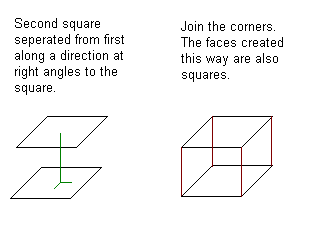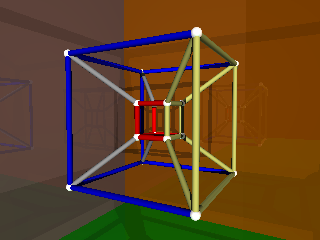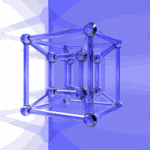Is a Tesseract the fifth dimension?
Message boards :
SETI@home Science :
Is a Tesseract the fifth dimension?
Message board moderation
| Author | Message |
|---|---|
|
Akhenaton Send message Joined: 11 Apr 03 Posts: 83 Credit: 4,128 RAC: 0 
|
Apparently this is called a Tesseract, and some say it represents the fifth dimension??? A tesseract is the four-dimensional equivalent of a cube. It would only be a five-dimensional object if you're counting time as a dimension. The space we're familiar with has three dimensions all at right angles to another. For example: up/down, forwards/backwards and left/right. You can specify the location of any point in our 3D space by giving its coordinates in those directions. When you go to four dimension you've got another direction that is at right-angles to all three of the original ones. You'll have trouble picturing that in your head, but mathematically it's perfectly fine. Now to go from a two-dimensional cube (a square) to a normal cube, what you have to do is lay one square flat. Then put another square and hover it above the first one. The important thing is that the second square is seperated from the first along the vertical direction, which you can see is at right angles to any line you can draw within the square. Now just connect the corners of one square and the corners of the other with lines. Make sense? It might help to try it with bits of paper so you can visualize what's happening. Okay. Now for the tesseract. This is the same sort of thing. Get two cubes, seperate them along the fourth dimension (which is at right angles to any line you can draw on a cube) and join the corners with lines. There's your tesseract. Of course you can't get a true idea of what it looks like in our 3D world so it's usually represented as a smaller cube inside a big one. |
 Sarge Sarge Send message Joined: 25 Aug 99 Posts: 12273 Credit: 8,569,109 RAC: 79 
|
Apparently this is called a Tesseract, and some say it represents the fifth dimension??? You apparently forgot to mention lengths of sides, only referring to right angles, unless I read too quickly. On the other hand, kudos that you indicated, at least indirectly, that it is an object within 4-dimensional space, rather than it REPRESENTING 4 dimensions (or 5). Capitalize on this good fortune, one word can bring you round ... changes. |
|
Akhenaton Send message Joined: 11 Apr 03 Posts: 83 Credit: 4,128 RAC: 0 
|
Okay, having read my reply, I realize it's less than clear. So I've quickly whipped up a couple of pictures to illustrate.  This is what I mean by making a cube from two squares.  This is a tesseract fomed from a blue outer cube and a red inner cube. The corners are joined by more lines. The interesting thing is that the internal bits that look like pyramids with the tops cut off (I've highlighted one yellow) are also CUBES in four dimensional space, and all the new faces are squares. It's just because we can't properly represent a four-dimensional object in three dimensions that these cubes and squares look distorted. BTW, I like your avatar. |
|
Akhenaton Send message Joined: 11 Apr 03 Posts: 83 Credit: 4,128 RAC: 0 
|
You're right. I didnt mention that the lines all have to be the same length. Otherwise you get a rectangular prism in the 3D case, and something I don't know the name of in 4D. Oops |
 Sarge Sarge Send message Joined: 25 Aug 99 Posts: 12273 Credit: 8,569,109 RAC: 79 
|
Not a problem. From what I've gathered, you're a sharp guy, and I figured either I was too tired to find where you'd mentioned it or just overlooked it. (To the readers: if you draw a cube on paper, you've drawn a projection of a 3-d object onto 2-d space.) I've seen the 3-d projection of a tesseract expressed differently. 2 congruent cubes were put side to side, with each of the 8 vertices of one cube connected by segments of the same length to the corresponding 8 vertices of the other cube. If I were more awake, I'd consider whether each is valid or not. Capitalize on this good fortune, one word can bring you round ... changes. |
 Misfit Misfit Send message Joined: 21 Jun 01 Posts: 21804 Credit: 2,815,091 RAC: 0 
|
Okay, having read my reply, I realize it's less than clear. So I've quickly whipped up a couple of pictures to illustrate. That is how you represent the shadow of a tesseract in 3-dimensional space. :) me@rescam.org |
 Sarge Sarge Send message Joined: 25 Aug 99 Posts: 12273 Credit: 8,569,109 RAC: 79 
|
That is how you represent the shadow of a tesseract in 3-dimensional space. :) A.K.A., the aforementioned projection. :) Capitalize on this good fortune, one word can bring you round ... changes. |
 Misfit Misfit Send message Joined: 21 Jun 01 Posts: 21804 Credit: 2,815,091 RAC: 0 
|
That is how you represent the shadow of a tesseract in 3-dimensional space. :) Yes, you are projecting. me@rescam.org |
![View the profile of KD [SETI.USA] Profile](https://setiathome.berkeley.edu/img/head_20.png) KD [SETI.USA] KD [SETI.USA] Send message Joined: 24 Oct 99 Posts: 459 Credit: 2,513,131 RAC: 0 
|
Apparently this is called a Tesseract, and some say it represents the fifth dimension??? Hi, Others have already answered your question, but you can also get a real simple explanation in one of Sagan's Cosmos series where he uses an analogy of "Flatland" to help describe the possible geometries of our universe. You can also buy (3D, obviously) tesseracts/hypercubes. I've seen them at that "science/imagination" store in malls, but they only have cheap plastic ones. I'd love to get a nice one made out of crystal... |
|
Airbuster Send message Joined: 22 Nov 05 Posts: 115 Credit: 1,342 RAC: 0 
|
This is Carl Sagan explaining the tesseract and the 4th dimension: http://www.youtube.com/watch?v=VareiRkDBLM |
|
Haos.PL Send message Joined: 18 Mar 04 Posts: 63 Credit: 3,268,546 RAC: 0 
|
I dont know why, but it looks like a cube-like torus, like a toroidial ring turned morphed in cube-like shape... This probably is confusing, but i`m prolly unable to think/see 4-dimensional at all:P |
 Demiurg Demiurg Send message Joined: 2 Jul 02 Posts: 883 Credit: 28,286 RAC: 0 
|
Question one. It is a 2D projection of a 3D simulation of a 4D tesseract. If you are into really strange shapes you should google for Calabi-Yau rooms up to the eleventh dimension in supersymmetric string theory. The projections of the simulations of the whatnots are stunningly beautiful. Question number two (the not asked one). We cannot in any way see a full representation beyond 3 room dimensions and 1 time. But in a one2one simulation we can handle it. Carl |
![View the profile of KD [SETI.USA] Profile](https://setiathome.berkeley.edu/img/head_20.png) KD [SETI.USA] KD [SETI.USA] Send message Joined: 24 Oct 99 Posts: 459 Credit: 2,513,131 RAC: 0 
|
This is Carl Sagan explaining the tesseract and the 4th dimension: http://www.youtube.com/watch?v=VareiRkDBLM Yep, that is it. The entire Cosmos series used to be online. The site I have bookmarked no longer has the videos though. They may still be if one google's hard enough though. (Better yet, anyone who hasn't watched them -- just buy the DVD set!) Has anyone come across a 3D tesseract, similiar to like the glass one Sagan used in that segment, that can be purchased? I'd love to get one that is really nice. Perhaps smaller than the one Sagan used in the video, but made of crystal. |
 Sarge Sarge Send message Joined: 25 Aug 99 Posts: 12273 Credit: 8,569,109 RAC: 79 
|
I think we need to clarify projections and cross-sections. I do not agree with the use of the terms. Nor do I agree with Sagan's presentation of the shadow of a cube into 2-d space. Backing it up, I do not agree with the 2-d representation of a 3-d representation of a tesseract (aka hypercube) as shown by Chris S's original post (and also featured in Cosmos). The 3-d representation of a tesseract that I have seen has some distinct differences. Capitalize on this good fortune, one word can bring you round ... changes. |
 Demiurg Demiurg Send message Joined: 2 Jul 02 Posts: 883 Credit: 28,286 RAC: 0 
|
I think we need to clarify projections and cross-sections. Yepp, I agree as I stated in my above post. Carl It is SEXY to DONATE! Skype = demiurg2 |
 Sarge Sarge Send message Joined: 25 Aug 99 Posts: 12273 Credit: 8,569,109 RAC: 79 
|
http://mathworld.wolfram.com/Tesseract.html Note that the two 3-d cubes are side by side, not one within the other. I'll post more on this later if I can, perhaps showing some step-by-step construction. Capitalize on this good fortune, one word can bring you round ... changes. |
 Sarge Sarge Send message Joined: 25 Aug 99 Posts: 12273 Credit: 8,569,109 RAC: 79 
|
Okay, having read my reply, I realize it's less than clear. So I've quickly whipped up a couple of pictures to illustrate. From http://www.geom.uiuc.edu/docs/holt/tesseract/top.html ... How to make a tesseract Akhenaton's post, quoted here, shows nicely Step 3: inflating from the 2-d square to the 3-d cube. Since we need the fourth dimension for the last step, and it must be mutually orthogonal to other three dimensions, well, I guess the quote is correct, there is no 3-d physical analog. But, the version I recall seeing (follow the MathWorld post) seems to make it easier to tell that the lengths of the segments connecting the two cubes are the same as the lengths of any of the segments from the previous steps. Capitalize on this good fortune, one word can bring you round ... changes. |
|
Akhenaton Send message Joined: 11 Apr 03 Posts: 83 Credit: 4,128 RAC: 0 
|
There's an excellent Java animation here, with various things you can adjust. I find it looks best if you set the projection to about 0.5, the speed to about 80. And if you can go cross-eyed, switch to the double view and go cross-eyed so the two views merge in the middle. |
 Sarge Sarge Send message Joined: 25 Aug 99 Posts: 12273 Credit: 8,569,109 RAC: 79 
|
There's an excellent Java animation here, with various things you can adjust. I find it looks best if you set the projection to about 0.5, the speed to about 80. And if you can go cross-eyed, switch to the double view and go cross-eyed so the two views merge in the middle. It's not helpful for me because I do not see two clearly resolvable cubes in there. Capitalize on this good fortune, one word can bring you round ... changes. |
|
Akhenaton Send message Joined: 11 Apr 03 Posts: 83 Credit: 4,128 RAC: 0 
|
Hit "Stereo" twice. You should get two tesseracts side by side. |

©2024 University of California
SETI@home and Astropulse are funded by grants from the National Science Foundation, NASA, and donations from SETI@home volunteers. AstroPulse is funded in part by the NSF through grant AST-0307956.
